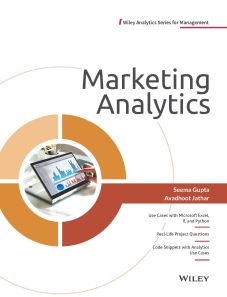Marketing Analytics
ISBN: 9789354242625
400 pages
For more information write to us at: acadmktg@wiley.com

Description
Marketing Analytics offers marketing students, teachers, and professionals a practical guide to marketing decision models and marketing metrics. The book offers unified reference for various marketing analytics use cases across industries and diverse businesses, such as consumer packaged goods marketers, restaurants and hospitality, e-commerce, entertainment, etc. It provides nuances and trade-offs in using statistical/machine learning methods for various marketing decisions. It explains key marketing metrics and their use with an analytics technique. It offers common best practices of the industry with choice of methods for various decision problems.
Chapter 1 Introduction
1.1 Marketing Analytics
1.2 Data for Marketing Analytics
1.3 What Are Business Intelligence, Analytics, and Data Science?
1.4 Analysis
1.5 Exploratory Data Analysis
1.6 Descriptive Analysis
1.7 Predictive Analytics
1.8 Prescriptive Analytics
1.9 Organization of the Book
Chapter 2 Segmentation
2.1 Introduction
2.2 Benefits of Customer Analytics
2.3 Factors Essential for Obtaining Benefits from Customer Analytics
2.4 Segmentation Analytics
2.5 Cluster Analysis
Chapter 3 Positioning
3.1 Introduction
3.2 Perceptual Mapping
3.3 White Spaces
3.4 Umbrella Brands
3.5 Multidimensional Scaling
Chapter 4 Product Analytics
4.1 Introduction
4.2 Analyzing Digital Products
4.3 Analyzing Non-Digital Products
Chapter 5 Pricing
5.1 Introduction
5.2 Goals of Pricing
5.3 Bundling
5.4 Skimming
5.5 Revenue Management
5.6 Promotions
5.7 Discounting
5.8 Price Elasticity of a Beverage Brand
Chapter 6 Marketing Mix
6.1 Introduction
6.2 Market Mix Modeling
6.3 Variables in Market Mix Modeling
6.4 Techniques of Market Mix Modeling
Chapter 7 Customer Journey
7.1 Introduction
7.2 Importance of Customer Journey
7.3 What is Customer Journey Mapping?
7.4 Customer Journey Mapping and Use of Analytics
7.5 How to Map a Customer’s Journey?
7.6 What Does Analytics with Customer Journeys Involve?
7.7 Customer Journey Use Case for a Beverage Brand
7.8 Journey of a Loyal Customer
7.9 Principal Component Analysis
7.10 Applying Principal Components to Brand
Chapter 8 Nurturing Customers
8.1 Introduction
8.2 Metrics for Tracking Customer Experience
8.3 Upgrading Customers: Use Case of Upselling
8.4 Logistic Regression Analysis
8.5 Use of Logistic Regression as a Classification Technique
Chapter 9 Customer Analytics
9.1 Introduction
9.2 Customer Lifetime Value
9.3 Churn Analytics
Chapter 10 Digital Analytics: Metrics and Measurement
10.1 Introduction
10.2 Important Web Metrics
10.3 Attribution Challenge and Shapley Regression
10.4 Test and Control or A/B Testing
10.5 Example Use Case: Webpage Design with A/B Testing
10.6 Search Engine Marketing
10.7 Search Engine Optimization
10.8 SEM or SEO: Which Is the Optimal Choice?
10.9 Social Media Analytics
10.10 App Marketing Metrics
Chapter 11 Artificial Intelligence and Machine Learning
11.1 Introduction
11.2 Importance of AI in Marketing
11.3 Key Applications of AI in Marketing
11.4 Common Terminologies – AI, ML, and DL
11.5 Important Concepts of ML
11.6 Random Forests
11.7 Model Evaluation Using ROC, AUC, and Confusion Matrix
11.8 Boosting Trees
11.9 Variable Importance
11.10 Simple Feed-Forward Network
11.11 Deep Neural Network
11.12 Image Recognition
11.13 Working with Textual Data
11.14 Recommendation Systems
11.15 Challenges Involved with AI
Chapter 12 Data Visualization
12.1 Introduction
12.2 Necessity of Data Visualization
12.3 Charts
12.4 Visualizations Useful with Common Data Science Techniques
12.5 Conclusion
Summary
Key Terms
Discussion Questions
Project
Appendix 1: Installing and Using R
Appendix 2: Installing Python
Endnotes
Index

